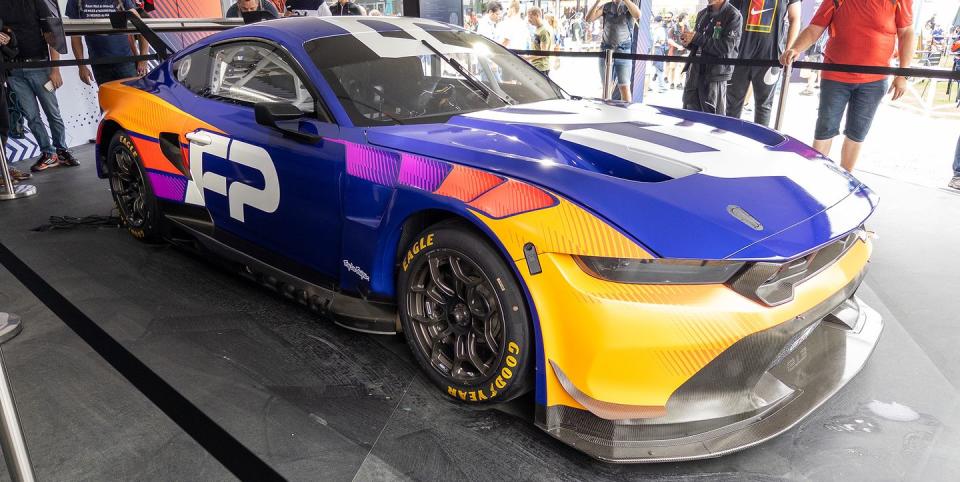Why the Ford Mustang GT3 Uses a 5.4-Liter V-8

At this past weekend's 24 Hours of Le Mans, Ford Performance unveiled its new Mustang GT3 race car, the first Mustang designed for the popular global category. It's built in collaboration with racing firm Multimatic, and uses a 5.4-liter V-8. That last point is interesting because the new Mustang doesn't use a 5.4-liter V-8—it has the familiar 5.0-liter Coyote.
"[W]e wanted to use a production engine, so we started with a 5.0-liter Coyote, and we wanted to maximize the displacement so we had more headroom for meeting the power requirements," Mark Rushbrook, head of Ford Performance, told Road & Track. "Within what's capable with a production block and heads is a 5.4."
GT3 racing is defined by Balance of Performance (BoP), a mechanism that evens out the performance between very different types of cars. Using an ever-changing combination ballast, intake restrictors, rpm limits, and boost limits (if applicable), BoP theoretically ensures that cars as different as, say, a BMW M4 and a Ferrari 296 can compete on equal footing. GT3 cars make around 500 horsepower give or take a few depending on BoP adjustments.
While the new Mustang Dark Horse's 5.0-liter makes an even 500, there are some instances where a little more power is necessary. Plus, increasing displacement means its easier to hit a 500-plus figure while putting less strain on engine components, especially important in endurance racing. Plus, one assumes a bump in displacement also means a bump in torque. Porsche takes a similar strategy for its 992-generation GT3 R race car, which uses an enlarged 4.2-liter flat-six while 911 road cars use engines no larger than 4.0 liters. So to does the Lexus RC F GT3, which has a 5.4-liter to the road car's 5.0.
Unlike the Mustang road car, the Mustang GT3 uses a rear transaxle gearbox, which Rushbrook said is primarily to help even out weight distribution. This might also allow Ford to move the V-8 further back in the chassis than in the street car, though we won't know that for certain until we get to see under the hood. Based on the photos Ford released, it appears that the driver sits further back in the cabin for weight distribution's sake too.
Rushbrook said that Ford hopes to have eight cars running next year, though that depends on when homologation is complete. Multimatic will run two cars in IMSA's GTD Pro category next year, while Proton Competition signed on to campaign the Mustang GT3 in the FIA World Endurance Championship, including Le Mans. Rushbrook says there should be cars in SRO and Pirelli World Challenge racing too. Beyond that, the Mustang GT3, as with all other GT3 cars, is available to customers. "We'll just keep building them," Rushbrook said, "We'll easily sell 30-50 cars. It's just a matter of how fast we can build them."
You Might Also Like

 Yahoo Autos
Yahoo Autos 